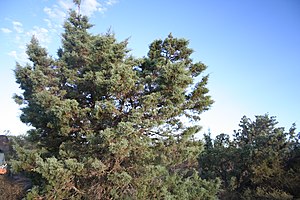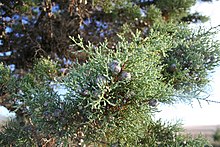Actinostrobus arenarius
| Actinostrobus arenarius | ||||||||||||
|---|---|---|---|---|---|---|---|---|---|---|---|---|

Actinostrobus arenarius |
||||||||||||
| Systematics | ||||||||||||
|
||||||||||||
| Scientific name | ||||||||||||
| Actinostrobus arenarius | ||||||||||||
| CA Garnder |
Callitris arenaria is a plant from the family of the cypress family (Cupressaceae). It isnative tothe western part of Western Australia .
description
Actinostrobus arenarius grows as an evergreen shrub or tree that can reach heights of up to 5 meters. The branches are just emerging from the trunk. The short branches have an approximately triangular cross-section.
The leaves of the young trees are blue-green in color. Older trees have blue-green to gray-green, scale-like leaves which are egg-shaped with a length of around 1.2 centimeters. They are slightly keeled, have a tapering leaf tip and there are three of them on the branches. Seedlings have two, rarely three, blue-green, pointed to rounded cotyledons , which are 9 to 14 millimeters long and 1.5 to 2 millimeters wide.
The male cones are cylindrical in shape with a length of 3 to 5 millimeters and a thickness of 1.5 to 2 millimeters. They consist of 16 to 18 egg-shaped or rounded cone scales. The female cones are conical-spherical in shape with a length of 1.5 to 2.0 centimeters and a thickness of 1.5 to 2.0 centimeters. They are initially blue-green in color and change color towards maturity. Each cone consists of six pointed cone scales, which bend back slightly when ripe and open the cone to release the seeds. The light brown to yellow-brown seeds are 0.6 to 1.1 centimeters long and have two or three 1 to 2 millimeter large wings.
Distribution and location
The natural range of Actinostrobus arenarius is in Western Australia . It extends there from Shark Bay in the north to the Wongan Hills in the south.
Actinostrobus arenarius grows mainly on sandy soils and on sandy plains.
Systematics
The first description as Callitris arenaria was made in 1964 by Charles Austin Gardner in the Journal of the Royal Society of Western Australia , Volume 47, page 54. synonyms for Callitris arenaria C.A. Gardner are Actinostrobus pyramidalis subsp. arenarius (CA Gardner) Silba , Actinostrobus pyramidalis var. arenarius (CA Gardner) Silba and Callitris arenaria (CAGardner) JEPiggin & JJBruhl .
Hazard and protection
Actinostrobus arenarius is classified as Least Concern in the IUCN Red List of 2013 .
swell
- Christopher J. Earle: Actinostrobus arenarius. In: The Gymnosperm Database. www.conifers.org, November 23, 2012, accessed January 6, 2013 .
Individual evidence
- ↑ a b c d e Christopher J. Earle: Actinostrobus arenarius. In: The Gymnosperm Database. www.conifers.org, November 23, 2012, accessed January 6, 2013 .
- ^ Actinostrobus arenarius at Tropicos.org. Missouri Botanical Garden, St. Louis, accessed January 6, 2013.
- ↑ Rafaël Govaerts (ed.): Actinostrobus. In: World Checklist of Selected Plant Families (WCSP) - The Board of Trustees of the Royal Botanic Gardens, Kew . Retrieved March 19, 2019.
- ↑ Actinostrobus arenarius in the endangered Red List species the IUCN 2013. Posted by: Thomas, P., IUCN SSC Conifer Specialist Group, 2010. Retrieved on January 19 of 2019.
